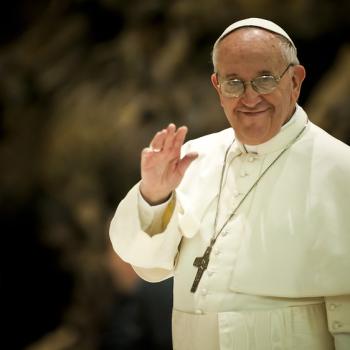+ Documentation of Pope Francis’ and Other Popes’ Use of the Mariological Title of Veneration: “Mother of All”

This particular controversy stems from a homily from Pope Francis, dated 12-12-19 (see it in Spanish), on the occasion of the Feast of Our Lady of Guadalupe. Crux published an article the next day by Inés San Martín, entitled, “Pope calls idea of declaring Mary co-redemptrix ‘foolishness’”. It stated:
Pope Francis appeared to flatly reject proposals in some theological circles to add “co-redemptrix” to the list of titles of the Virgin Mary, saying the mother of Jesus never took anything that belonged to her son, and calling the invention of new titles and dogmas “foolishness.” . . .
What Francis said Thursday is in line with Cardinal Joseph Ratzinger, the Vatican’s doctrinal chief during most of St. John Paul II’ papacy, and now Pope emeritus Benedict XVI.
Speaking with Peter Seewald for the book-length interview published as God and the World: A Conversation, the then cardinal said: “The formula ‘co-redemptrix’ departs to too great an extent from the language of Scripture and of the Fathers, and therefore gives rise to misunderstandings.”
“Everything comes from Him [Christ], as the Letter to the Ephesians and the Letter to the Colossians, in particular, tell us; Mary, too, is everything she is through Him,” Ratzinger said. “The word ‘co-redemptrix’ would obscure this origin. A correct intention being expressed in the wrong way.”
The radical Catholic reactionary site, Church Militant also posted a similar mistaken article on 12-13-19.
There are several things going on here at once (including misrepresentation), that need to be explained. First of all, the issue of co-redemptrix is mostly one of whether it is the best term to describe what is firmly entrenched in Catholic belief and doctrines: Mary Mediatrix (which can also be grounded in the Bible). The two notions (though one can note certain fine-tuned distinctions) are virtually the same. Both are widely and vastly misunderstood, but co-redemptrix is relatively more misunderstood and much less used in Catholic circles.
Pope Benedict XVI accepts this doctrine (“correct intention” above), and he referred to Mediatrix, for example, in general audiences of 10-27-10 and 3-30-11, and a homily dated 1-1-07. On 2 February 2006: he stated: “Bringing her Son to Jerusalem, the Virgin Mother offered him to God as a true Lamb who takes away the sins of the world. She held him out to Simeon and Anna as the proclamation of redemption; . . .” And likewise, on on 11 May 2007: “There is no fruit of grace in the history of salvation that does not have as its necessary instrument the mediation of Our Lady.” He simply thinks that the term co-redemptrix is not the best one to use to describe this doctrine. I happen to personally agree.
Pope St. John Paul II has used the term co-redemptrix on at least five occasions in the course of his papal teachings (see extensive documentation on this). In his greetings to the sick after the general audience of 8 September 1982:
Mary, though conceived and born without the taint of sin, participated in a marvelous way in the sufferings of her divine Son, in order to be Coredemptrix of humanity.
In his 4 November 1984 Angelus address in Arona:
To Our Lady—the Coredemptrix—St. Charles turned with singularly revealing accents.
31 January 1985: address at the Marian shrine in Guayaquil, Ecuador:
Mary goes before us and accompanies us. The silent journey that begins with her Immaculate Conception and passes through the ‘yes’ of Nazareth, which makes her the Mother of God, finds on Calvary a particularly important moment. There also, accepting and assisting at the sacrifice of her son, Mary is the dawn of Redemption;…Crucified spiritually with her crucified son (cf. Gal. 2:20), she contemplated with heroic love the death of her God, she “lovingly consented to the immolation of this Victim which she herself had brought forth” (Lumen Gentium, 58)…
In fact, at Calvary she united herself with the sacrifice of her Son that led to the foundation of the Church; her maternal heart shared to the very depths the will of Christ ‘to gather into one all the dispersed children of God’ (Jn. 11:52). Having suffered for the Church, Mary deserved to become the Mother of all the disciples of her Son, the Mother of their unity….In fact, Mary’s role as Coredemptrix did not cease with the glorification of her Son.
31 March 1985: Palm Sunday and World Youth Day:
At the Angelus hour on this Palm Sunday, which the Liturgy calls also the Sunday of the Lord’s Passion, our thoughts run to Mary, immersed in the mystery of an immeasurable sorrow. Mary accompanied her divine Son in the most discreet concealment pondering everything in the depths of her heart. On Calvary, at the foot of the Cross, in the vastness and in the depth of her maternal sacrifice, she had John, the youngest Apostle, beside her….May, Mary our Protectress, the Coredemptrix, to whom we offer our prayer with great outpouring, make our desire generously correspond to the desire of the Redeemer.
Commemoration of the sixth centenary of the canonization of St. Bridget of Sweden on 6 October 1991:
Birgitta looked to Mary as her model and support in the various moments of her life. She spoke energetically about the divine privilege of Mary’s Immaculate Conception. She contemplated her astonishing mission as Mother of the Saviour. She invoked her as the Immaculate Conception, Our Lady of Sorrows, and Coredemptrix, exalting Mary’s singular role in the history of salvation and the life of the Christian people.
Pope St. John Paul II has also frequently expressed the conceptual equivalent, without using that word, repeatedly in his encyclical of 25 March 1987, Redemptoris Mater (Mother of the Redeemer), and on the dates 9-26-86, 4-9-97, and 8-15-01 (see all these cited at length in my post, “Mary Mediatrix: St. John Paul II & Benedict XVI Clarify”).
With that necessary background, let us now examine this latest “controversy” and how the Crux article was factually mistaken. Marian scholar, Dr. Mark Miravalle wrote on 12-13-19:
The accurate words of the key lines of the homily of Pope Francis, given in Spanish during his non-scripted ex tempore homily, are as follows:
“Faithful to her Master, who is her Son, the unique Redeemer, she never wanted to take anything away from her Son. “She never introduced herself as ‘co-redemptrix.’ No. ‘ disciple” (Fiel a su Maestro, que es su Hijo, el ùnico Redentor, jamàs quiso para si tomar algo de su Hijo. Jamàs se present como co-redentora. No. discipula”).
Our Holy Father is completely accurate in stating that Mary never “introduced herself” as “co-redemptrix,” neither in the context of the Annunciation nor in the historical events at Guadalupe, the subject of his homily. This, though, does not in itself deny the doctrinal legitimacy of the co-redemptrix title when it is used with its proper meaning in referring to the unique participation of Mary in the historical Redemption accomplished by Jesus Christ, the only divine Redeemer. . . .
The co-redemptrix title for Our Lady has been part of the Church’s Tradition since the 14th century and has been used correctly to identify Our Lady’s unequaled cooperation in the Redemption by popes, saints, mystics, bishops, clergy, theologians, and the faithful People of God, including by recent saints including St. Pio of Pietrelcina, St. Maximilian Kolbe, St. Maria Benedicta of the Cross, St. Josemaría Escrivá, St. Teresa of Calcutta, and, again, Pope St. John Paul II. . . .
Pope Francis also strongly confirms in his December 12 homily the legitimacy of the title, “mother of all,” which has been proposed over the last century (starting in 1915) as the overall title and doctrine for a potential Marian definition, as presently none of the existing four dogmas (Mother of God, Perpetual Virginity, Immaculate Conception, Assumption) refer to Mary’s direct and maternal relationship with humanity as our Spiritual Mother.
Pope Francis has used the pious description “mother of all” with reference to the Blessed Virgin Mary on many other occasions as well:
Mary, the first and most perfect disciple of Jesus, the first and most perfect believer, the model of the pilgrim Church, is the one who opens the way to the Church’s motherhood and constantly sustains her maternal mission to all mankind. Mary’s tactful maternal witness has accompanied the Church from the beginning. She, the Mother of God, is also the Mother of the Church, and through the Church, the mother of all men and women, and of every people. May this gentle and loving Mother obtain for us the Lord’s blessing upon the entire human family. (Homily, 1-1-15)
To grow in tender love, and a respectful and sensitive charity, we have a sure Christian model to contemplate: Mary, the Mother of Jesus and our Mother, who is always attentive to the voice of God and the needs and troubles of her children. Mary, impelled by God’s mercy which took flesh within her, selflessly hastened from Galilee to Judea to find and help her kinswoman Elizabeth. She interceded with her Son at the wedding feast of Cana when she saw that there was a shortage of wine. She bore in her heart, throughout the pilgrimage of her life, the words of the elderly Simeon who foretold that a sword would pierce her soul, and with persevering strength she stood at the foot of the cross of Jesus. She knows the way, and for this reason she is the Mother of all of the sick and suffering. To her we can turn with confidence and filial devotion, certain that she will help us, support us and not abandon us. She is the Mother of the crucified and risen Christ: she stands beside our crosses and she accompanies us on the journey towards the resurrection and the fullness of life. (Message, 12-6-13)
Mary is the Mother of Jesus and is, in Him, the Mother of all of us: the Mother of unity. (Address, 5-10-18)
Blessed are you, Mary, for you gave the Son of God to our world. But even more blessed are you for having believed in him. Full of faith, you conceived Jesus first in your heart and then in your womb, and thus became the Mother of all believers (cf. Saint Augustine, Sermo 215,4). (Homily, 1-1-16)
And at the foot of the Cross of Jesus, we also meet the Sorrowful Mother. She is the Mother of all humanity, and she is always close to her sick and ailing children. If our faith waivers, hers does not. May Mary always sustain you and your commitment to research and action in your work. (Address, 4-12-14)
May Mary, Mother of all people, accompany and protect the missionaries of the Gospel each day. (Angelus, 10-20-19)
May Mary, Mother of the Prince of Peace and Mother of all the peoples of the earth, accompany and sustain us at every step of our journey of reconciliation. (Message for World Day of Peace, 12-8-19)
It will also benefit us this week to think about the joy of Mary, the Mother of Jesus. Just as her pain was intimate enough to pierce her soul, so too her joy was also intimate and deep, and the disciples were able to draw from it. Having passed through the experience of the death and Resurrection of her Son, seen in faith as the supreme expression of God’s love, Mary’s heart became a font of peace, consolation, hope and mercy. All of the prerogatives of our Mother derive from this, from her participation Jesus’ Paschal Mystery. From Friday until Sunday morning she did not lose hope: we contemplated the sorrowful Mother but, at the same time, the Mother full of hope. She, who is the Mother of all of the disciples, the Mother of the Church, is the Mother of hope. (Regina Caeli, 4-21-14)
Nor is he starting anything new in speaking in this way:
In the saints one thing becomes clear: those who draw near to God do not withdraw from men, but rather become truly close to them. In no one do we see this more clearly than in Mary. The words addressed by the crucified Lord to his disciple—to John and through him to all disciples of Jesus: “Behold, your mother!” (Jn 19:27)—are fulfilled anew in every generation. Mary has truly become the Mother of all believers. Men and women of every time and place have recourse to her motherly kindness and her virginal purity and grace, in all their needs and aspirations, their joys and sorrows, their moments of loneliness and their common endeavours. They constantly experience the gift of her goodness and the unfailing love which she pours out from the depths of her heart. (Pope Benedict XVI, encyclical letter Deus caritas est, 12-25-05, section 42)
[T]he Mother of God, the Virgin Mary, who is also the most loving mother of all, will assist all of you with her most efficacious protection. (Ven. Pope Pius XII, encyclical Ad Sinarum Gentem, 10-7-54, section 29)
From the same fact that the most holy Virgin is the mother of Jesus Christ is she the mother of all Christians whom she bore on Mount Calvary amid the supreme throes of the Redemption; . . . (Pope Leo XIII, encyclical Quamquam Pluries, section 3)
The great sign which the Apostle John saw in heaven, “a woman clothed with the sun,”(1) is interpreted by the sacred Liturgy,(2) not without foundation, as referring to the most blessed Mary, the mother of all men by the grace of Christ the Redeemer. The memory, venerable brothers, is still vivid in our mind of the great emotion we felt in proclaiming the august Mother of God as the spiritual Mother of the Church, . . . (Pope St. Paul VI, apostolic exhortation Signum Magnum, 5-13-67, Introduction)
Mary, you are the “model of the Church in faith, charity and perfect union with Christ” (Lumen Gentium, 63). You freely accepted God’s will, made known to you at the Annunciation. You bore in your womb the Word made flesh, who dwelt among us as your Son. You watched him grow “in wisdom and age and grace” (Luc 2,52) in the home of Nazareth. Your path of discipleship led even to the foot of the Cross, where Jesus made you the Mother of all his followers (Cfr. Io 19,27). (Pope St. John Paul II, Angelus, 8-15-93)
Pope Francis also makes numerous references to the “intercession” of Mary.
My friend, systematic theologian Dr. Robert Fastiggi, has expressed himself in correspondence regarding this controversy. He has written articles about Marian coredemption, and was president of the Mariological Society of America from 2014-2016. Dr. Fastiggi gave me permission to cite his words:
Pope Francis was not forbidding the Marian title of co-redemptrix, and he was not closing the door to further theological development. . . .
The headline [of the Crux article] is misleading. The Holy Father does not use the term “co-redemptrix” in the paragraph in which he speaks of “foolishness” (toneteras). That comes six paragraphs later. . . .
Here is the paragraph in which Pope Francis speaks of foolishness:
Cuando nos vengan con historias de que había que declararla esto, o hacer este otro dogma o esto, no nos perdamos en tonteras: María es mujer, es Nuestra Señora, María es Madre de su Hijo y de la Santa Madre Iglesia jerárquica y María es mestiza, mujer de nuestros pueblos, pero que mestizó a Dios.
When they come to us with stories about having to declare this, or make this or that other dogma, let’s not get lost in foolishness. Mary is woman, she is Our Lady, Mary is the Mother of her Son and of the Holy Mother hierarchical Church and Mary is mestiza, the woman of our peoples, but also mestizó to God.” (my translation).
Pope Francis does not say declaring Mary to be co-redemptrix is foolishness. It seems that [he] wants us to approach Mary first as our Mother and not get lost in requests for dogmas. In this he’s like St. John XXIII who received many petitions to define Mary as “Mediatrix of all graces” at Vatican II but made it clear he did not want any new dogmas proclaimed at the council.
It would be foolishness to get so lost in requests for dogmas that we become distracted from loving Mary as our Mother, Our Lady, and the Mother of the Church. This in itself, though, does not preclude further theological development in Marian doctrines by Pope Francis or future popes. It also does not preclude a proper use of the term, co-redemptrix in reference to Mary (a term used publicly by Pius XI and St. John Paul II).
***

















